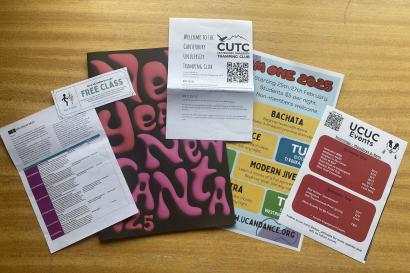After a 7.1 magnitude earthquake struck Christchurch in 2010, University of Canterbury (UC) student Sam Johnson knew he had to do something. So he created a Facebook group for students who wanted to volunteer to help with the clean up. The group gained serious momentum over time, and before long, his casual Facebook group turned into an official UC student organization with chapters all over the country, as well as recognition and partnerships from all over the world. Still today, the organization engages 3000 students a year at UC alone. It is called the Student Volunteer Army (SVA). If you’re interested in learning more about this amazing organization, you can check out their website here: https://sva.org.nz/
Thankfully, the UC SVA hasn't had to do much earthquake response lately. They are still extremely active though, hosting the annual Big Give (where this year they volunteered in the residential red zone, which was hit hardest by the earthquakes), coordinating weekend projects like beach cleanups, and organizing camps (overnight volunteer trips). On a bit of a whim, I signed up for their first camp of the year, located about 3 ½ hours away in the small town of Twizel. For $20 NZD they provided transport, food, and accommodation. All we had to do was show up and be ready to put in some good hard mahi (work) in the outdoors.
When we arrived, we went straight to our lodge (basically a hallway lined with rooms filled with bunks) at a holiday park in Twizel. However, we did most of our volunteering in the nearby Lake Ōhau area. For this particular camp we mostly focused on conservation work. The first full day, you could choose between planting native trees, using loppers to cut down invasive wilding pines, or place trap lines for invasive animals. I went with the trap line option since I had seen the traps everywhere on my tramps and was curious about the process, and because it was the best opportunity to get a wee tramp in while also giving back to the environment.
A bit of a tangent about trapping in NZ: Across New Zealand there are varying levels of invasive animals such as possums, rats, ferrets, stoats, hedgehogs, and more. They disrupt the environment in various ways, including directly killing native birds and decimating food resources key to the stability of the rest of the ecosystem. For example, in the Lake Ōhau area, animals like possums devour the native mistletoe species. These species live in symbiosis with the trees and, when they bloom, provide an important food source for the birds that depend on nectar. Without the mistletoe, the entire system is affected.
In order to control these invasive mammals, a massive trapping effort has been employed all over New Zealand. We're talking 180,000 of these traps managed by the Department of Conservation alone, as well as more localized efforts run by independent organizations. The traps are carefully weighted and sized to only catch what they're designed to, so smaller things like birds won't set them off and bigger things like dogs have trouble getting in. They are almost all placed by people on foot, and set and checked the same way, so it's easy to imagine the massive effort and sheer amount of people required to do that for 10,000s of heavy wood and metal traps across the country, many in the most remote areas.
Encouragingly though, conditions have improved since trapping started, with some native bird species slightly recovering and the ecosystems responding accordingly. There's still a lot to be done, but there's already some islands that have been declared predator free, and with trapping continuing, hopefully that can be said for areas on the mainland eventually as well. While the invasive mammals are the poster villain at the forefront of the trapping effort, it's important to remember that they are just animals too, and obviously don't act maliciously. The humans who first introduced them are the true ones to blame, and mistakes like that are part of the reason New Zealand’s biosecurity has to be so tight. Having developed with so little outside influence, Aotearoa’s ecosystems are extremely vulnerable to foreign flora and fauna. However, it also makes them some of the most unique and important to protect.
This is why I was keen to help with the trapping, even though I know it doesn't get at the root of the issue of people introducing harmful species. We worked together with the Ōhau Conservation Trust to place the traps along a few different tracks in the nearby mountains and valleys. Overall I would say we placed about thirty or so, each 200 meters apart. Later, members of the Trust will return to actually set the traps. We used a couple different trap designs, but they were all quite heavy. To carry them we were given special frames/harnesses that were carried on your back just like a tramping pack, with a hip and chest strap and everything. The trap(s) sat on the shelf jutting out from the frame, and then straps were used to tie it down the rest of the way. (You can see the setup in the photos below.) I only carried one and that was adequately heavy. I was impressed with the people who carried two, and not surprised when they gave a smile of relief after one of their traps was taken off their back and placed along the track. By working in pairs, one person was able to carry the trap(s) while the other carried a day pack with both people's water, snacks, layers, etc. Being in partners also allowed a chance to switch off when the first person needed a break from carrying the trap.
The best part about this job was that it was basically a tramping outing that happened to include placing traps. We got to experience two different tracks that traversed beautiful mushroom-y beech forests, followed tumbling creeks that we could drink directly from, and wound through tussocked plains. When we returned to camp late in the afternoon, we had walked about 13 km (~8 miles) and were very ready for our dinner of Kiwi nachos (which is basically corn chips with chili and shredded cheese poured over it).
The next day, instead of splitting into groups we used our full 80 person power to replant the Avoca forest. A few years ago it was largely burned down by a summer wildfire. Although the fire was a disaster, it also provided an opportunity to replant the forest with all native species. An ecologist had already designed a plan for where each species should be placed, so we just had to grab a sapling and a shovel, and plant it by the pole of that species' corresponding color. The saplings were all collected from the nearby bush that survived the fire, and after only two hours we had planted all of them. I planted around eight, so we must have planted a couple hundred trees at least. It felt good to look over the grass-and-burned-wood-covered landscape and see all our little saplings happily peeking out of the ground. After the planting we all enjoyed a Kiwi BBQ with sausages on white bread for the meat eaters and hash brown patties on white bread for the vegetarians. All covered in trademark Kiwi tomato sauce of course. Then we packed up in the vans and returned to Christchurch.
Although I wasn't planning to go on this trip more than a week in advance, I was really happy I happened to see the email and went for it. I signed up not knowing anyone else who was going, but ended up making friends with some really cool Kiwis as well as a Canadian and some Americans I hadn't met before. And of course, it was really rewarding to be able to give back to Aotearoa's natural environment, which has given me so many amazing experiences and memories. If you ever find yourself a student at UC, check out the SVA. You can sign up for their email list at the club’s fair, or just keep an eye out for their adverts. They're a great organization, and they provide a very cheap chance to get out of the UC bubble and give back to the community and country that is hosting you.
Until next time, get outdoors and soak up the sunshine if you can. :)
Cheers!








Anna Marie Riner
Kia ora! My name is Anna Marie, and I am a creative, outdoorsy individual from the Black Hills in South Dakota. This semester, I'm excited to be crossing the globe to New Zealand for some studying, tramping (hiking), eating, birding, interning, exploring and much more.
















